
Church frescos or church wall paintings are to be found in some 600 churches across Denmark, no doubt representing the highest concentration of surviving church murals anywhere in the world. Most of them date back to the Middle Ages and were uncovered by Jacob Kornerup (1825–1913) who carried out restoration work in 80 churches across the country towards the end of the 19th century. They lay hidden for centuries as after the reformation, they were covered with limewash only to be revealed and restored during the course of the 19th and 20th centuries. In most of Europe medieval frescos, extremely common in the Middle Ages, were more likely to be removed completely during the Reformation or in subsequent rebuildings, or merely as they aged. The oldest frescos, dating back to the 12th century, were painted in the Romanesque style by artists from elsewhere in Europe but those from the 14th century and thereafter are in the Gothic style which was used by native Danish painters. It is these that are considered to be the most important for Danish art and culture. A distinction is to be made between these church wall paintings or kalkmalerier and the generic term "fresco" which refers to all types of painting on plastered walls or ceilings.
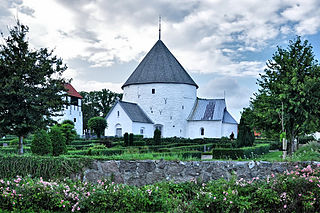
Nylars Church is a 12th-century round church in the village of Nylars near Rønne in the south of the Danish island of Bornholm. Originally designed for a defensive role, the solid structure contains a series of 13th-century frescos, the oldest of Bornholm's four round churches.

Væggerløse Church is a Romanesque church in the village of Væggerløse, 7 kilometres (4.3 mi) south of Nykøbing on the Danish island of Falster. Its early 16th century frescos depict the Supper at Emmaus.

Aastrup Church, located on the top of a steep hill in the village of Aastrup, 6 kilometres (3.7 mi) southwest of Stubbekøbing on the Danish island of Falster, dates from c. 1200. Built in the Late Romanesque style, it has frescos from the 13th and 15th centuries.
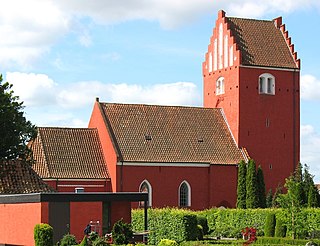
Nørre Alslev Church in the small town of Nørre Alslev in the north of Danish island of Falster dates from at least 1308, a date found on its early frescos. Built in the Early Gothic style and painted pink according to local tradition, it is best known for its fresco of the death dance.

Torkilstrup Church is located in the village of Torkilstrup some 7 km (4 mi) southeast of Nørre Alslev, on the Danish island of Falster. It is built of hewn fieldstone rather than brick, indicating it is one of the oldest churches on the island from before 1160.

Stubbekøbing Church is located in Stubbekøbing some 18 km (11 mi) northeast of Nørre Alslev on the Danish island of Falster. The basilical nave was built of limestone in the Late Romanesque period. Choir and tower are of brick, the choir built in Early Gothic style, tower and the northern chapels in the 15th century in Late Gothic style. In addition to its Renaissance altarpiece and pulpit, it has a variety of old frescos and wall decorations (1300–1500).

Brarup Church is located in the village of Brarup some 5 km (3.1 mi) southwest of Nørre Alslev on the Danish island of Falster. The Late Romanesque church has frescos from various periods including several by the Brarup Master and his workshop from the early 16th century.

Eskilstrup Church is a church in Eskilstrup, Denmark. The church dates from the 12th century and was built in the Romanesque style. In accordance with a local tradition, it is painted red. It is best known for its frescos, said to be Denmark's oldest.

Freerslev Church is located in the Danish Diocese of Roskilde, Faxe Municipality in Region Sjælland on the island of Zealand. Parts of the original Romanesque church subsist today although there have been substantial Gothic additions. Primitive 14th-century frescos have been uncovered in the arch of an old window on the north wall.

Toreby Church is the parish church of Toreby on the Danish island of Lolland. It is an unusually large red-brick Romanesque building, the nave and chancel having been extended in the Gothic period with a sacristy and lateral aisle. The tower is late Romanesque. There are frescos from c. 1400 in the sacristy. The carved pulpit (1645) is the work of Jørgen Ringnis.

Nørreballe is a village on the Danish island of Lolland. With a population of 478, it is located 6 km (3.7 mi) northwest of Maribo. The village of Østofte with its 14th-century Østofte Church is now part of Nørreballe.

Østofte Church, located in the village of Nørreballe on the Danish island of Lolland, was built in the 14th century. The Romanesque apse, chancel and nave formed the original building while the tower and porch were added in the Late-Gothic period and the north wing was completed in 1656.
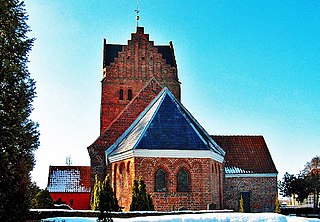
Stokkemarke Church is located in the village of Stokkemarke some 11 km (6.8 mi) northwest of Maribo on the Danish island of Lolland. Dating from the middle of the 13th century it was built in the Romanesque style with later additions in the Gothic period.

Hunseby Church is located in the village of Hunseby some 3 km north of Maribo on the Danish island of Lolland. Built in the middle of the 12th century, the church has a Romanesque chancel and nave and a Gothic tower.

Sandby Church is located in the village of Sandby some 7 km northwest of Nakskov on the Danish island of Lolland. Dating from the middle of the 13th century, the church has a Romanesque chancel and nave and a Late Gothic tower.

Sandby is a village located some 7 km (4.3 mi) northwest of Nakskov on the Danish island of Lolland. It belongs to Lolland Municipality in Region Sjælland. As of 2023, it has a population of 356.
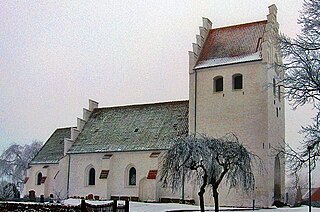
Errindlev Church is located in the village of Errindlev some 8 km northwest of Rødby on the Danish island of Lolland. Dating from the second half of the 12th century, the church has a Romanesque chancel and nave.
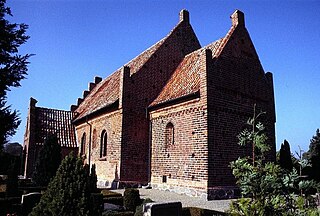
Olstrup Church is a Romanesque church in open country west of Errindlev in the south of the Danish island of Lolland. There are 16th-century frescos of the Last Judgment on the chancel arch with Christ sitting on a rainbow.
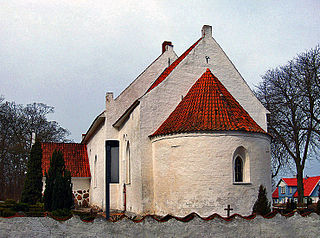
Arninge Church is a Late Romanesque church in the little village of Arninge, some 8 km (5.0 mi) south of Nakskov on the Danish island of Lolland. Built of red brick in the 13th century, it has an intricately carved auricular altarpiece created by Henrik Werner in 1644.



























